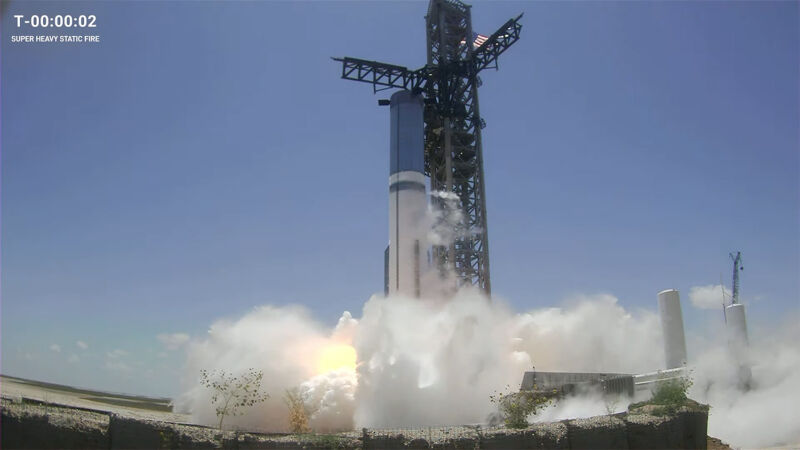SpaceX Successfully conducts its Super heavy booster test Rocket
Over the weekend, SpaceX conducted a static fire test of a new Super Heavy booster at its South Texas launch site. The ignition of 33 engines was quite a spectacle, and the outcome of the short-duration test firing had both positive and negative takeaways.
On the positive side, the rocket, named Booster 9 due to its iterative design methodology, successfully passed the test and seemed to be in good condition afterward. Furthermore, SpaceX’s extensively rebuilt ground systems, including an upgraded water suppression system, appeared to function well in safeguarding both the rocket and the launch pad.
The recent test of SpaceX’s rocket did not go as planned. The test only lasted 2.74 seconds, shorter than the intended five seconds. Additionally, four of the rocket’s 33 main Raptor engines shut down prematurely, indicating that SpaceX is still facing challenges with the reliability of its engines. Despite intense efforts to improve their performance, the “Raptor 2” engines that power this rocket are proving problematic. SpaceX is currently working on an upgraded “Raptor 3” version to address this issue.

Moving ahead
Over the weekend, SpaceX conducted tests that brought them closer to a second launch of their Starship vehicle. The full stack of the rocket includes the Super Heavy booster and Starship upper stage. It remains to be seen whether SpaceX will perform additional tests of this booster or if Sunday’s testing provided enough data to proceed with a launch attempt this fall.
It’s still being determined how far away SpaceX is from a second Starship launch attempt. To provide some context, 70 days passed between the static fire test of Booster 7, which powered the first Starship launch, and its liftoff. Unfortunately, the debut launch failed on April 20 due to engine issues and other problems that doomed the flight of the booster stage.
Notably, the latest test occurred on a Sunday, a rare occurrence since SpaceX can only close the road leading to its launch site and Boca Chica Beach on a few weekends per year. This indicates that there is some urgency with this launch campaign. The hope is that the upcoming launch will be successful and bring us one step closer to exploring space in a new way.
SpaceX has made significant strides since the failed April 20 launch attempt that caused severe damage to the Orbital Launch Mount and other ground equipment in South Texas. Engineers and technicians have made notable progress, having installed an extensive water deluge system that appeared to be successful during a test on July 28.
The system features a thick perforated steel plate beneath the rocket, which sprays jets of water to counter the heat and acoustic energy generated by the 33 Raptor engines when they fire. On Sunday, the system produced enormous steam, as planned.
In the previous launch attempt, the absence of a sound suppression system led to significant damage, including the release of concrete chunks from the launch pad that scattered debris for miles around the Starbase site. The Federal Aviation Administration investigates this issue as SpaceX seeks a new launch license. Moreover, environmental groups have filed a lawsuit against the Federal Aviation Administration to prevent the issuance of a new license.
Regulators require data
SpaceX likely gathered a wealth of data during Sunday’s launch to assess the performance of the launch site and water deluge system. This information is crucial for the Federal Aviation Administration’s licensing process. However, the flight termination system for the rocket remains an unresolved issue.
During the inaugural flight, the system was initiated less than 90 seconds in, but there was a delay of about 40 seconds before the rocket broke apart. Although there were no safety concerns, this delay is unacceptable for a system that should terminate flights almost immediately. Elon Musk has suggested that a longer detonation cord could solve the problem. Still, he acknowledged that it might take some time to work through the issue with the Federal Aviation Administration. Musk said that the requalification of the flight termination system is likely the most extended lead item. Still, there have been no updates from him or the Federal Aviation Administration since.
This article was first published in ArsTechnica